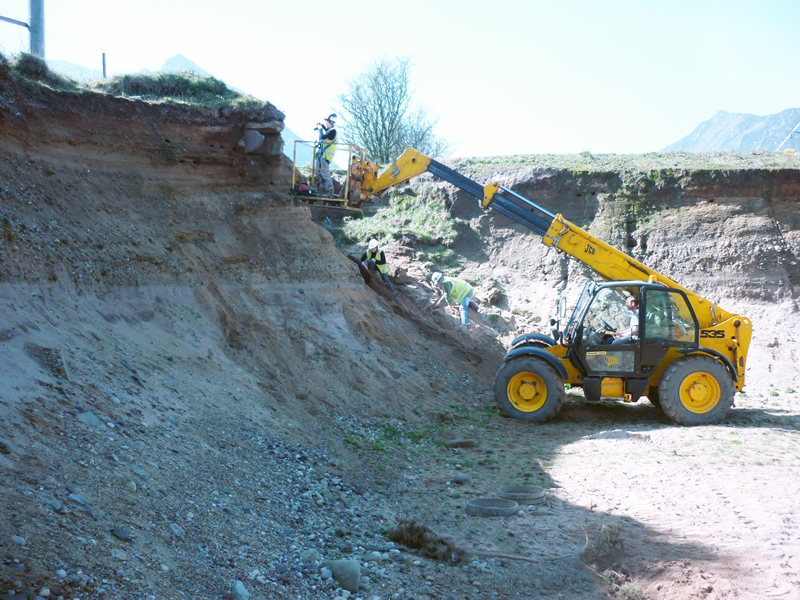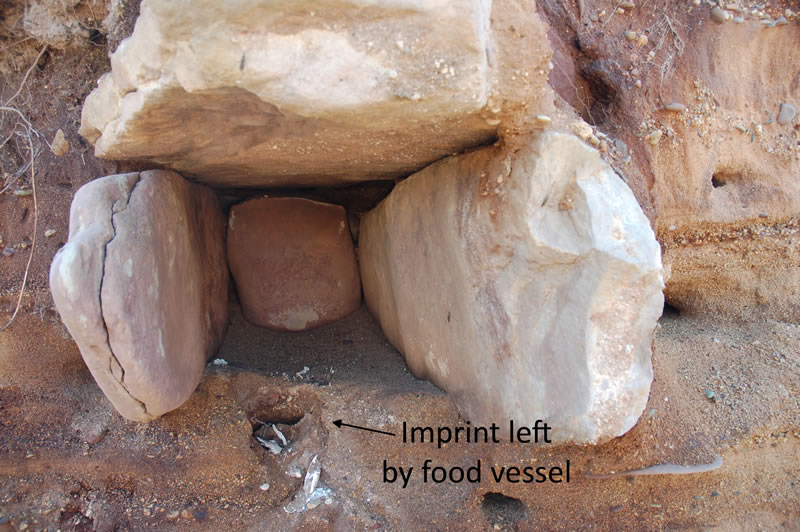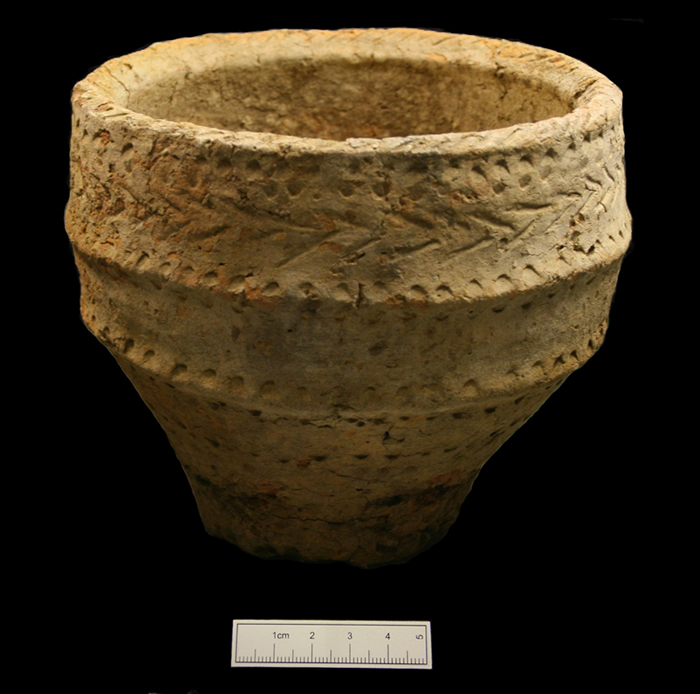In March 2012, the landowner and a local resident spotted a short stone cist exposed in the cliff face of a disused quarry at Sannox on the Isle of Arran. They alerted the West of Scotland Archaeology Service, which prompted Historic Scotland to commission GUARD Archaeology to undertake a rescue excavation.
A GUARD Archaeology team, led by Iraia Arabaolaza, were sent to investigate the site; not an easy task given the high exposed location of the cist. The first thing the team did was to clean the exposed section of the eroding face of the sand cliff using a mechanical cherry-picker. This revealed not just the one but two cists. The subsequent excavation of the cists required the GUARD Archaeologists to wear harness and be tied to a fixed point at all times. However, the team successfully recovered and recorded the archaeological remains and brought them back to GUARD Archaeology's laboratory in Glasgow for specialist analyses, which has only just now been completed.
Only one of the cists contained a human cremation, which yielded a radiocarbon date of 2154 - 2026 BC, placing the cist burial in the early Bronze Age. Analysis of the cremated bone, by Iraia, who is also one of GUARD Archaeology's Osteoarchaeologists, revealed that it belonged to an adult of indeterminate sex. The texture, cracks and warping of the bones suggests that the body was still fleshed when cremated and it is likely that the cremation occurred soon after death. A small rounded button-shaped dense bone was recorded in one of the skull fragments and is most likely an osteoma, a form of benign tumour, which may not have caused the person any distress or symptoms during their lifetime. The weight of the cremated bone was smaller than the average weight of a complete adult cremation, which implies either that not all the cremated bone had been collected and moved from the original pyre site before burial, or that a substantial amount of it had been lost during the erosion and collapse of the quarry cliff face. However, the smaller weight of the bones, as well as the absence of the axial bones, is a common trait in many Bronze Age cremation burials. Another possibility is that some of the cremated bone was taken somewhere other than the grave. A comparison could be drawn with ethnographic evidence from nineteenth century Aborigines, for instance, where cremated bone was given to mourners as keepsakes. The lack of remains such as substantial amounts of charcoal associated with a pyre also reinforces the idea of a selected burial. Green staining was observed on a distal end of a right humerus and a fragment of unidentified long bone, which could be evidence for the presence of a copper or copper-alloy object on the body during the cremation, or the inclusion of such an object with the cremated bone. However, no such object was apparent in the cists, which could be due to an intentional retrieval of it after the cremation and before the burial.
The cremated bone was accompanied by a tripartite Food Vessel and scale-flaked flint knife. Bronze Age cremation burials in Scotland are often accompanied by a pottery vessel and a flint knife. Analysis of the knife revealed that this was made from flint from Yorkshire and had probably been used for cutting/sickling grasses or cereals. Analysis of the food vessel has also revealed a number of things. The appearance of the vessel suggests that it may have stood in a hot fire. There is no sooting from flames, but the base of the pot indicates heat erosion. Excessive heat may have also been a cause of the cracks. One interpretation could be that the vessel was positioned on the edge of the funeral pyre, perhaps in order to fire it during the cremation of the body. In doing so, it received damage as it was not protected from direct flames or very hot ashes. The impression in the floor of the cist may indicate where and how it lay - in the middle on its side, but slightly to the east. The Food Vessel is especially noteworthy because its decoration is most closely comparable with vessels found in the eastern parts of Scotland and England. One of the questions that the east coast associations of the food vessel and flint knife pose is why they were buried here on the west coast of Scotland? The exact nature of this association is unclear. It could be related to the exchange of materials and objects as well as ideas or immigration.
While the second cist was empty, a charcoal fragment from it was radiocarbon dated to 3520 - 3368 BC; which is extremely early for such cist burials and may instead correspond to earlier activities in the area.
Both cists, and the human remains and grave goods found within Cist 1, provide a window into the complex and varied mortuary practices of early Bronze Age Scotland. The ritual of cremation was an important rite and the one most frequently practiced during the Bronze Age. The increasing reduction of woodland that started in the Neolithic and continued through the early Bronze Age meant that wood was scarce. A tonne of wood was necessary in order to fully cremate the bones. The use of this scarce and therefore valuable object indicates the importance that Bronze Age society gave in providing the deceased with a 'good ceremony', which could reinforce the deceased's status or that of the community where they resided. The inclusion of grave goods with clear associations with the east coast, and therefore most likely relatively valuable items emphasizes the significance given to the burial.
This work was funded by Historic Scotland, under the terms of their Human Remains Call-off Contract, which was established to provide a rapid response for the recovery of archaeological human remains discovered by members of the public in Scotland. The full results of this research, ARO10: The cliff hanging cists; Sannox Quarry, Isle of Arran has just been published and is now freely available to download from the ARO website - www.archaeologyreportsonline.com.



